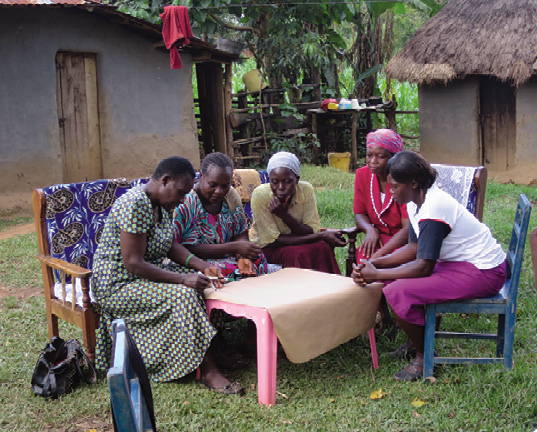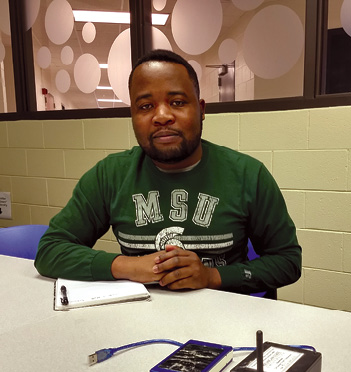Designing for Africa
- Susan P. Wyche
- Associate Professor
- Department of Media and Information
- College of Communication Arts and Sciences

Women draw garden tools in rural Kenya.
 The familiar story that, by leap-frogging over the need for extensive infrastructure, new mobile technologies are making life better for people in Africa, is more complex than is usually told. Susan Wyche, an assistant professor in the Department of Media and Information who studies how technology is being used in Africa, particularly in rural Kenya, questions the value of that narrative.
The familiar story that, by leap-frogging over the need for extensive infrastructure, new mobile technologies are making life better for people in Africa, is more complex than is usually told. Susan Wyche, an assistant professor in the Department of Media and Information who studies how technology is being used in Africa, particularly in rural Kenya, questions the value of that narrative.
"There's this myth and enthusiasm and optimism for mobile phones, but I think a lot of the work I've done is bringing a more critical lens to that," Wyche said. "I think it really hasn't had the transformative and revolutionary impact that some media reports might say it has. It's easy to get excited about the technology without taking a step back and asking if this is really fixing some of the persistent problems, underlying issues that still haven't been addressed—like incomes and women's education."
For example, she explained, having apps that allow someone to transfer money directly to someone else are of little use if users don't have money to transfer. Meanwhile, even charging the phone, making phone calls, and texting present challenges for many users. Few people in rural Kenya have access to reliable electricity, so they need to buy solar panels or find someone with access to power to charge their phones. There are few smartphones, so users are usually learning to text on a numerical keypad, which can be a significant obstacle to some.
Using technology in Africa often requires the participation of an entire community. Neighbors have to work together to get what they need and want from their phones. In some villages, there may only be one or two people with access to electricity to charge phones, and maybe someone else who helps when neighbors need to text a cousin in the city.
In her approach to work in Africa, Wyche is keen to understand how technologies are actually used by people, what technologies are useful, and how design can address persistent problems and make people's lives better. All of this involves close engagement with communities.
Several years ago, while researching technology used in rural Kenya, Wyche saw that many farmers did not know how to effectively use their mobile phones. To help them learn, she partnered with Mediae, a production company that produces "Shamba Shape Up," an agricultural advice TV show aimed at helping farmers increase their crop yields and run their farms more efficiently. Shamba is an East African word for farm. Together they created a series of videos to air on the show.
 Patricia Gichinga is the producer for the Mediae Company and worked with Wyche on these videos. "After the initial research, MSU developed three short training videos to help participants understand how to use the phone. These were then tested in the field," she said. "This was assessed and the training clips adapted and then the lessons learned from this allowed 'Shamba Shape Up' to design new material for inclusion into three five- to six-minute slots within the series."
Patricia Gichinga is the producer for the Mediae Company and worked with Wyche on these videos. "After the initial research, MSU developed three short training videos to help participants understand how to use the phone. These were then tested in the field," she said. "This was assessed and the training clips adapted and then the lessons learned from this allowed 'Shamba Shape Up' to design new material for inclusion into three five- to six-minute slots within the series."
According to Gichinga, the program reached 4.5 million viewers in Kenya and another 2.5 million viewers in Tanzania and Uganda. "As a result, we have continued to include information in every episode on how to access valuable information by mobile phone, and we have seen a considerable increase in users," she said. "We now have iShamba, which is a mobile backup platform to 'Shamba Shape Up,' with over 275,000 farmers on the database."
Designing for People
As Wyche explores how technology is being used in Africa, she often employs what she calls "unconventional research methods"—such as cultural probes and technical probes.
"These methods are sort of grounded in art more than science, but I think they are useful for understanding the human aspects of everyday life in rural Kenya where we work, more so than a survey would be," she said.
Cultural probes helped Wyche and her team research how Kenyans were using a popular domestic lighting system called M-Kopa. The system is powered by solar energy, so it addresses the need of people living beyond the wired power grid.
"We had 22 households that we visited, and we talked to them about M-Kopa," she said. "We went back to their houses at night to see how they used the system, and we found that for the most part it's really successful."
The research also raised some more questions. M-Kopa is often marketed as something that is environmentally friendly and sustainable, but Wyche and her team found that once people had purchased the lighting system—often on an incremental pay-as-you go plan—they eventually wanted the next M-Kopa accessory, like a television or radio. Then, when it's all paid off, they can just keep making payments and get an updated system. "There is this sense of, is it really sustainable or is this system just something that introduces people to buying more stuff," Wyche said.
Technology for Domestic Security

Media and Information grad student Hope Chidziwisano is looking at how users interact with technology in Kenya.
Hope Chidziwisano is a graduate student in the Department of Media and Information at MSU. He did his undergraduate studies in computer science and physics at University of Malawi, Chancellor College. He met Wyche, who is now his advisor, in Malawi in 2014. Currently he is looking at how users interact with technology in Kenya.
Recently Chidziwisano developed a small home-security system, which he named M-Kulinda—kulinda is a Swahili word for "security." He distributed the devices to 20 households and followed how people used the devices for a month. Most of the participating homes did not have electricity, so solar panels were used to charge the device's batteries during the day. The device he developed is essentially a motion detector that can alert homeowners by text.
"This system is put inside a home," he said. "When it detects motion, it sends a message to the homeowner's mobile phone, saying 'There's something going on in your house, maybe the sensor has been activated.'"
To understand how the devices were used, he used technology probes. Chidziwisano explained: "The technology probes method combines three goals. There is the social science part of collecting data, and then you also have the engineering goal of trying to test the system, and then you ask questions to get reflections from people on the technology."
Participants were asked to record their impressions of the technology throughout the project. Those were gathered along with data on how the devices performed. Some of the results were surprising: "Another good thing about the technology probe is that you just give technology to the people. You don't know, there are always unexpected things that come out," Chidziwisano said. "For example, we told them that this is a security system that you use in your home, but then some people were using it to monitor their family members—maybe their daughters—to see what they were doing."
Another user was concerned about his chickens. In particular, he was losing chicks. So he used the device to find out what was happening. It turned out there was a rat that was coming up at night and taking them.
"Hope is addressing this issue that he knows is important," Wyche said. "Domestic security—just making sure nobody comes to your house at night and steals your chickens—has been really overlooked in the literature."
Garden Hoes
After years of researching how Kenyans use technology, Wyche's understanding of what works and what is needed in terms of design has changed. Consider the jembe or garden hoe. Kenyan farmers rely heavily on this piece of technology. The jembe was developed generations ago and makes farming possible.
"As an American who attended mostly technical universities in my academic career, I went to Kenya thinking the mobile phone was the most important piece of technology," she said. "But after 10 years I've realized that these garden hoes are actually more important."
So Wyche is currently working on a project funded by the Alliance for African Partnership (see page 33 for more information about AAP) to redesign the jembe. She is inviting rural farmers to participate in design workshops, and together they are figuring out ways to make an already successful piece of technology even better.
This approach to redesigning a traditional tool embodies Wyche's philosophy when engaging communities in research. It is the people who use and will use the technology—in this case Kenyan farmers—who best identify technological needs and then drive design decisions.
- Written by Matt Forster, University Outreach and Engagement
- Photographs courtesy of Susan Wyche and Paul Phipps, University Outreach and Engagement